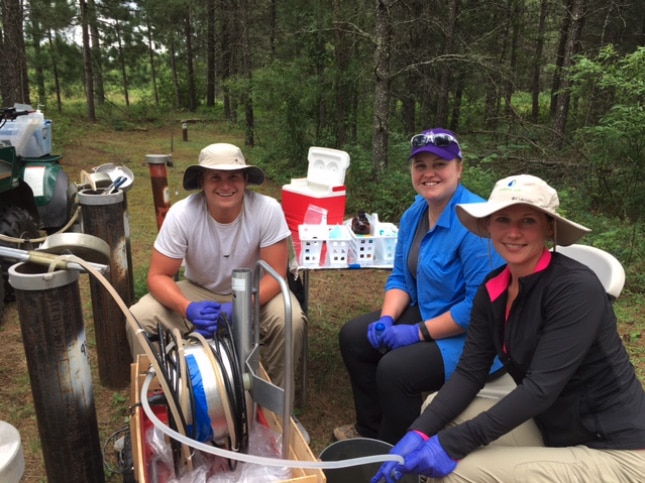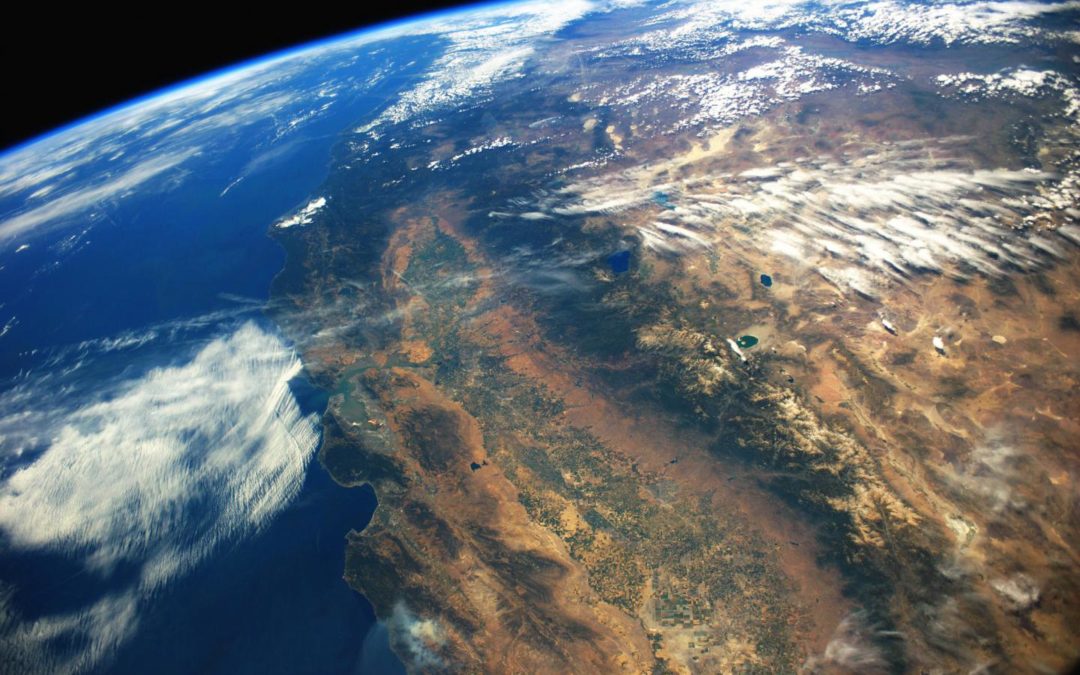Biogeochemical controls on natural and anthropogenic groundwater contaminants in California’s Central Valley
Overview: Groundwater in California’s Central Valley is subject to contamination by a variety of natural and human-sourced contaminants. This presents potential human health hazards and financial challenges to water treatment municipalities. Notable contaminants in the Central Valley like nitrates from fertilizer application as well as agricultural chemicals (herbicides, pesticides, fertilizers, etc.) are used to increase agricultural productivity. Both contaminants can trigger biological and geochemical processes that support the release of trace elements (e.g., uranium, chromium, arsenic) from an immobile phase in sediments to a dissolved phase in groundwater, where they can contaminate drinking water resources. This problem may also be exacerbated by increasing groundwater pumping and extraction. This project will combine sampling water from wells, collecting sediment cores, and a laboratory analysis component to characterize the groundwater chemistry, mineralogy, and microbiology of the samples collected. The overall goal of this research project is to better resolve the influence of human activity on biological and geochemical processes that create unsafe levels of trace elements in groundwater in the Central Valley.

Geologists coring sediment adjacent to water wells
When: June 15 – July 19, 2020
Where: California State University, Fresno, and the surrounding area
Who: Dr. Brady Ziegler, Trinity University; Dr. Aric Mine, California State University, Fresno
Prerequisites and Recommended Courses: This project is highly interdisciplinary in nature, combining aspects of hydrogeology, geochemistry, and microbiology (i.e., biogeochemistry). As such, an outstanding applicant for this project will have taken one or more of the following:
- Introductory Geosciences Course(s)
- General Chemistry (preferably I and II) with laboratory
- Introductory Biology with laboratory
- College-level Mathematics (e.g. Calculus, Statistics, Differential Equations)
Expectations and Obligations:
We seek motivated, driven students that are comfortable working independently and that can work and collaborate well with others. You will be expected to take ownership of your project with guidance from the advisors. This entails collecting, organizing, analyzing, interpreting and presenting data in written and oral form. Students on this project are obligated to:
- Participate in all project-related work during the summer (June 15-July 19, 2020)
2. Write a team abstract and present a paper (poster or talk) at the Geological Society of America National Meeting in Montreal, Quebec, Canada, October 25-28, 2020 (all expenses covered)
PROJECT DESCRIPTION
Potential student projects, to be conducted by a pair of students per project, include:
Project 1: Characterization of aquifer sediment chemistry
Project 2: Microbial community analysis in groundwater and aquifer sediments
Project 3: GIS data compilation; sampling survey and chemical analysis of groundwater in and surrounding Fresno, CA
Project 4: High frequency, long-term monitoring of a newly installed well on CSUF campus

Changes in the Central Valley – Left: USGS photo from Mendoza, CA in the Central Valley showing land surface subsidence over the time points on the signage. (USGS). Center: Subsidence in the Central Valley, shown spatially from 5/10/2015 to 9/10/2016 (NASA). Right: Groundwater concentrations of Nitrate in municipal and personal wells throughout the state. The maximum contamination limit (MCL) in California is 10 mg/ml (nitrate as N) (Honeycutt et al, 2011)
PROJECT LOGISTICS
Students will fly to Fresno on the weekend of June 14 and move into on-campus housing at CSUF.
Starting June 15, two-to-three days will be dedicated to training students in field methods and the overall project objectives. After the training session, students will then participate in a variety of field work, including the installation of a new well on the campus of CSUF, collection of sediment cores, and sampling of public supply wells in coordination with the city of Fresno, and perhaps sampling of residential wells and monitoring wells owned by the California Water Science Center.
After the first ~1.5 weeks, many of the field samples processing will be complete in the lab and characterization via the methods above will begin. During this heavily analytical period, a subset of students will search online databases to extract groundwater chemistry data and use geographic information systems to produce spatial distribution maps for groundwater contaminants relevant to the project. Meanwhile, another subset of students will be responsible for regular (daily or every other day) monitoring and sampling of the newly installed well in the CSUF campus. We may have students switch tasks throughout this period so each student participating in the project gets a chance to experience each component of this interdisciplinary research.
During the last week, students will collaborate to write and submit multiple abstracts (actual number to be determined based on analytical results) for posters to be presented at the Geological Society of America meeting in Fall 2020. Students will depart Fresno on July 19.
Safety: All students will be responsible for completing an online laboratory safety training exercise prior to arrival at CSU Fresno. This will be supplemented by an in-person field-safety training and laboratory safety training specific to the laboratory you’ll work in.
PROFESSIONAL DEVELOPMENT
In the last week of the research period, students will collaborate with one another with guidance from Ziegler and Mine to write abstracts for the national Geological Society of America Meeting in Montreal, Canada (GSA dates: Oct 25-28, 2020). It is likely that multiple abstracts will be submitted, with a pair of students taking the lead on each abstract, though the other students would likely be co-authors on each project.
Student researchers for the project will travel to GSA, where the primary co-authors of the project will present a poster or talk of their research results. Students will participate in student-focused activities at GSA, many of which encourage students to clarify their education and career plans and establish a network of geosciences professionals. The summer experience and presentation at GSA aim to excite students in the field of research and the pursuit of science, technology, and mathematics careers
References
Adler, H. H. (1974). Concepts of uranium-ore formation in reducing environments in sandstones and other sediments. In Formation of uranium ore deposits, Proceedings of a Symposium; Athens, May 6-10, 1974, International Atomic Energy Agency, Vienna.
Burow, K. R., Jurgens, B. C., Belitz, K., Dubrovsky, N. M. (2013). Assessment of regional change in nitrate concentrations in groundwater in the Central Valley, California, USA, 1950s-2000s. Environmental Earth Sciences, 69(8), 2609–2621. https://doi.org/10.1007/s12665-012-2082-4
Davis, G. H., Green, J. H., Olmsted, F. H., Brown, D. W. (1959). Ground-water conditions and storage capacity in the San Joaquin Valley, California. USGS Water Supply Paper 1469. US Geological Survey. https://doi.org/10.3133/wsp1469
DeSimone, Leslie A., Pixie A. Hamilton. (2009) Quality of water from domestic wells in principal aquifers of the United States, 1991-2004. USGS Scientific Investigation 2009-1332. US Geological Survey.
Eary, L. E., Rai, D. (1987). Kinetics of chromium (III) oxidation to chromium (VI) by reaction with manganese dioxide. Environmental Science & Technology, 21(12), 1187-1193. https://doi.org/10.1021/es00165a005
Faunt, C. C., Sneed, M., Traum, J., Brandt, J. T. (2016). Water availability and land subsidence in the Central Valley, California, USA. Hydrogeology Journal, 24(3), 675-684. https://doi.org/10.1007/s10040-017-1654-5
Hansen, J. A., Jurgens, B. C., Fram, M. S. (2018). Quantifying anthropogenic contributions to century-scale groundwater salinity changes, San Joaquin Valley, California, USA. Science of the Total Environment. https://doi.org/10.1016/j.scitotenv.2018.05.333
He, Y. T., Fitzmaurice, A. G., Bilgin, A., Choi, S., O’Day, P., Horst, J., … Hering, J. G. (2010). Geochemical processes controlling arsenic mobility in groundwater: A case study of arsenic mobilization and natural attenuation. Applied Geochemistry, 25(1), 69–80. https://doi.org/10.1016/j.apgeochem.2009.10.002
Jurgens, B. C., Fram, M. S., Belitz, K., Burow, K. R., Landon, M. K. (2010). Effects of Groundwater Development on Uranium: Central Valley, California, USA. Ground Water, 48(6), 913–928. https://doi.org/10.1111/j.1745-6584.2009.00635.x
Kurttio, P., Auvinen, A., Salonen, L., Saha, H., Pekkanen, J., Mäkeläinen, I., … & Komulainen, H. (2002). Renal effects of uranium in drinking water. Environmental Health Perspectives, 110(4), 337-342.
https://doi.org/10.1289/ehp.02110337
Langmuir, D. Aqueous Environmental Geochemistry (1997). Prentice Hall: Upper Saddle River, NJ.
McClain, C., Fendorf, S., Johnson, S., Menendez, A., Maher, K. (2019). Lithologic and redox controls on hexavalent chromium in vadose zone sediments of California’s Central Valley. Geochimica et Cosmochimica Acta, 265, 478–494. https://doi.org/10.1016/j.gca.2019.07.044
Mills, C. T., Goldhaber, M. B. (2012). Laboratory investigations of the effects of nitrification-induced acidification on Cr cycling in vadose zone material partially derived from ultramafic rocks. Science of the Total Environment, 435, 363-373.
Mills, C. T., Morrison, J. M., Goldhaber, M. B., Ellefsen, K. J. (2011). Chromium(VI) generation in vadose zone soils and alluvial sediments of the southwestern Sacramento Valley, California: A potential source of geogenic Cr(VI) to groundwater. Applied Geochemistry, 26(8), 1488–1501. https://doi.org/10.1016/j.apgeochem.2011.05.023
Nolan, B. T., Gronberg, J. M., Faunt, C. C., Eberts, S. M., Belitz, K. (2014). Modeling nitrate at domestic and public-supply well depths in the Central Valley, California. Environmental Science & Technology, 48(10), 5643-5651. https://doi.org/10.1021/es405452q
Nolan, J., Weber, K. A. (2015). Natural uranium contamination in major US aquifers linked to nitrate. Environmental Science & Technology Letters, 2(8), 215-220. https://doi.org/10.1021/acs.estlett.5b00174
Nriagu, J. O., Nieboer, E. (Eds.). (1988). Chromium in the natural and human environments (Vol. 20). John Wiley & Sons.
Olmsted, F. H., Davis, G. H. (1961). Geologic features and ground-water storage capacity of the Sacramento Valley, California. USGS Water Supply Paper 1491. US. Geological Survey. https://doi.org/10.3133/wsp1497
Page, R. W. (1986). Geology of the fresh ground-water basin of the Central Valley, California: with texture maps and sections. Professional Paper 1401-C. US Geological Survey. https://doi.org/10.3133/pp1401C
Rosen, M. R., Burow, K. R., Fram, M. S. (2019). Anthropogenic and geologic causes of anomalously high uranium concentrations in groundwater used for drinking water supply in the southeastern San Joaquin Valley, CA. Journal of Hydrology, 577, 124009. https://doi.org/10.1016/j.jhydrol.2019.124009
Weber, K. A., Thrash, J. C., Van Trump, J. I., Achenbach, L. A., Coates, J. D. (2011). Environmental and taxonomic bacterial diversity of anaerobic uranium (IV) bio-oxidation. Applied Environmental Microbiology, 77(13), 4693-4696. https://doi.org/10.1128/AEM.02539-10
Tessier, A., Campbell, P. G., Bisson, M. (1979). Sequential extraction procedure for the speciation of particulate trace metals. Analytical Chemistry, 51(7), 844-851. https://doi.org/10.1021/ac50043a017
Ure, A. M., Quevauviller, P. H., Muntau, H., Griepink, B. (1993). Speciation of heavy metals in soils and sediments. An account of the improvement and harmonization of extraction techniques undertaken under the auspices of the BCR of the Commission of the European Communities. International Journal of Environmental Analytical Chemistry, 51(1-4), 135-151. https://doi.org/10.1080/03067319308027619.

